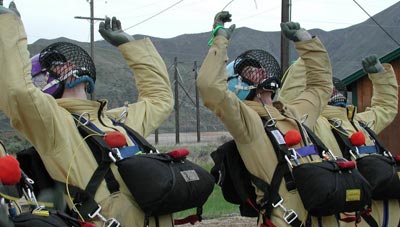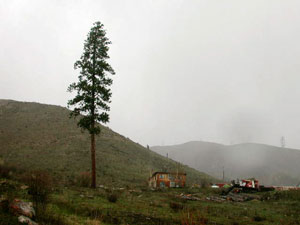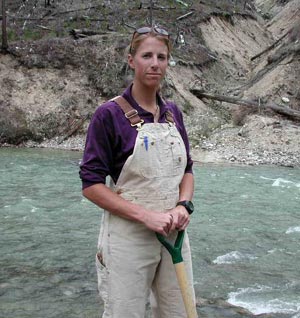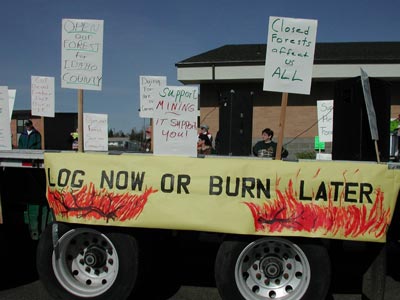Fanning the Flames on the Forest Fire Debate
Air Date: Week of June 6, 2003
Last summer’s wildfires have triggered calls for massive forest thinning. A bill that would allow just that is now before Congress. But in speaking with fire ecologists, producer Guy Hand found few who believe large-scale thinning is either useful, or possible.
Transcript
CURWOOD: It’s Living on Earth. I’m Steve Curwood. Last summer, after flying over the Biscuit fire, Oregon’s largest wildfire in over 100 years, President Bush told the crowd that catastrophic, unnatural fires were destroying America’s forests. As huge fires burned in Colorado and Arizona, the president seemed to have a point. His solution, called the Healthy Forests Initiative, promises to thin federal forests aggressively and remove the timber that can help fires spread. But many scientists say wildfires are part of nature’s way and do not permanently scar the landscape.
As the 2003 fire season begins, producer Guy Hand, of Radio High Country News, wanders into the woods for a closer look at the nature of big fire.
INSTRUCTOR: All right, keep your hands on your head.
HAND: In the foothills near Boise, Idaho, instructors are training a new batch of smoke jumpers, those firefighters who parachute into the mountains, working to put out wildfires before they get big.

Smoke jumper trainees practice for their first jump near Boise, Idaho.
(Photo: Guy Hand)
INSTRUCTOR: What do you want to be?
TRAINEES [IN UNISON]: Smoke jumpers!
INSTRUCTOR: What do you want to be?
TRAINEES [IN UNISON]: Smoke jumpers!
INSTRUCTOR: All right!
HAND: Feet dangling from a 34-foot high training tower, Lisa Allen is suited up for her first practice jump.
INSTRUCTOR: Now, one jumper. Are you ready?
ALLEN: I’m ready.
INSTRUCTOR: Psyched?
ALLEN: I’m psyched.
INSTRUCTOR: Let’s go.
HAND: The training tower looks like the inside of a jump plane. Instructors are trying to make the experience as real as possible.
INSTRUCTOR: You’ve got about 200 yards drift. Watch out for the rocks and jump spot. Jump spot elevation is 4,000 feet. We’re flying standard pattern, into the wind. Get ready.
HAND: The instructor slaps Lisa on the back and she leaps into the air, arms raised over her head, yelling out procedures as she slides down the long cable she’s hooked to.
INSTRUCTOR: Go, go.
[SOUNDS OF JUMPERS YELLING.]
HAND: Smoke jumpers help to make wildland firefighting incredibly efficient. Last summer crews put out 99 percent of all the wildfires in America, but it’s a costly annual effort.
ALLEN: I could not get my head down.
HAND: In the 2002 fire season, expenses shot to nearly $2 billion dollars. The Forest Service had to steal a billion dollars of that from its other programs. On the summer’s busiest single day, 28,000 people, 1,200 fire engines, 188 helicopters, 30 air tankers and an Army battalion were battling wildfires. It comes very close, in dollars and devotion, to all-out war. Smoke jumper Allen is proud to be a part of the fight.
ALLEN: I love wildlife firefighting. There’s a thrill to it. There’s a sense of accomplishment.
HAND: There’s also a sense of urgency. You can hear it in the nightly news.
PETER JENNINGS: In Colorado tonight, a growing army of firefighters remains on the lines between the state’s worst ever wildfire and the southern suburbs of Denver.
HAND: That one percent of wildfires that get away seem to be burning more acres, more intensely than ever before. Last year, over seven million acres burned on federal land, prompting President Bush to announce his Healthy Forests Initiative.
FEMALE COMMENTATOR: …the fire near Yakima, Washington. It exploded from just a few acres to thousands in a matter of hours.
HAND: The Bush administration says fires are burning far beyond the bounds of nature. It blames decades of fire suppression for unhealthy forests, forests now choked with combustible fuel. To make the woods grow again, those fuels have to be removed, not only around communities, but some say, deep into the backcountry, as well.
MALE COMMENTATOR: The moisture content is five percent or lower. That is so dry that it just reacts with fire-- it almost explodes.
HAND: President Bush says the work has to be done quickly. That’s why the Healthy Forests Initiative emphasizes cutting not only trees, but what it calls excessive environmental analysis and public involvement.
[APPLAUSE.]
BUSH: People are beginning to get the message. And Americans who have no idea what good forest policy means are beginning to see the fires on TV-- it’s a sad way for people to learn.
HAND: But after the smoke clears and the media moves on, many scientists see a far different picture. They say these large fires are seldom catastrophic or unnatural. In the backcountry where communities aren’t threatened, big fire is often beneficial. Fire scientists worry that politicians and reporters are missing an important ecological point.
VAP: You see the pictures on TV, the flames just totally out of control, and everything being consumed.
HAND: Sue Vap is the fire director for the National Park Service.
VAP: But everything really wasn’t consumed. You do have remnants of the trees left. In a lot of cases wildlife can make good use of those. It doesn’t become a sterile landscape; it becomes a changed landscape.
HAND: Tom Zimmerman, Fire Science Ecology Program leader for the National Park Service:
ZIMMERMAN: Our view of what we’ve interpreted as being catastrophic is a little different than what the media’s been presenting as catastrophic. And I think what we see, from my standpoint, is that many of these fires may be large, but aren’t what we would term as catastrophic in the sense that they’re not causing severe damage, threatening life and property on a large scale area. They just happen to be large fires.
HAND: Places like Yellowstone, a park that some declared destroyed after the immense fires of 1988, now show remarkable recovery. Fire can restore watersheds, recycle nutrients, and more. Even the Oregon fires President Bush used as a backdrop for his speech on the Healthy Forests Initiative did not burn unnaturally, according to scientists. Here in Idaho, biologist Tim Burton found similar results while studying the effects of big fire on the state’s forest fisheries.
BURTON: When we looked at high severity, burning that is enough to actually kill the trees, we found that only a fairly small percentage of the forest actually burned at this high severity. Tended to be in very small patches.
 Lowman, Idaho in the aftermath of one of the biggest ponderosa pine fires in local history. (Photo: Guy Hand) Lowman, Idaho in the aftermath of one of the biggest ponderosa pine fires in local history. (Photo: Guy Hand) |
HAND: Burton found that most trees weren’t affected at all by big fire. A few looked devastated, their sheltering vegetation burned away, their channels choked with sediment.
BURTON: We couldn’t find fish in some of these streams anymore. They were gone. But the streams were still connected to downstream rivers, where there were colonizers that came back, and as a habitat restored itself the numbers of fish that we observed seemed to restore themselves. HAND: Burton says his findings are mirrored by other studies. Scientists who look at birds, plants and other facets of fire-affected ecosystems are seeing that species can recover and even flourish after so-called catastrophic fire. BURTON: After as few as five years, we saw many or even more fish in those streams than we had seen prior to the flood events. HAND: But the beneficence of big fire is hard for Westerners to swallow. That’s why we like what science has said about the lowland Ponderosa pine forest. The theory goes that small, frequent fires once burned there. Flames quietly crawled along the forest floor, cleaning away debris like well-mannered housekeepers, leaving large trees alive, if lightly toasted. Then we came along. A century of logging and fire suppression later, Ponderosa pine habitat is a thicket of flammable fuel, turning good fire to bad. The Bush administration has seized on this theory, reasoning that American society created the era of big fire and therefore, has the power and the duty to stop it. With aggressive thinning, we can return the forest to its once peaceable affiliation with fire. We can, in other words, have our forest and fire too. PIERCE: Well, I’ll try to keep it simple. HAND: Yet as much as 60 percent of Western woodlands doesn’t fit the quiet fire, ponderosa pine model. Forests at higher altitude or in cooler, wetter parts of the West don’t burn nearly as often. Fuels build up over decades or centuries. When those overgrown forests light up, they explode. And, they do it naturally. PIERCE: Okay. To someone who’s not been doing this, this may all just seem like a pile of dirt.
|

 Geologist Jennifer Pierce looking for evidence of ancient wildfires beneath the charred remnants of a recent one. (Photo: Guy Hand)
HAND: Jennifer Pierce has just climbed a steep slope to Ponderosa pine in the Boise National Forest, the kind of forest that policy-makers say should burn quietly. But she’s found evidence to the contrary.
Geologist Jennifer Pierce looking for evidence of ancient wildfires beneath the charred remnants of a recent one. (Photo: Guy Hand)
HAND: Jennifer Pierce has just climbed a steep slope to Ponderosa pine in the Boise National Forest, the kind of forest that policy-makers say should burn quietly. But she’s found evidence to the contrary.





